Strategic Management Report: Zara's Australian Market Analysis
VerifiedAdded on 2023/03/17
|9
|2176
|81
Report
AI Summary
This report provides a comprehensive strategic analysis of Zara in the Australian fashion retail market. It begins with an introduction to the industry, its background, and the challenges faced by both single and multi-brand retailers, including increasing competition, rising lease costs, and cautious consumer spending. The report then conducts an external analysis using PESTLE, examining the political, economic, social, technological, legal, and environmental factors impacting Zara. An internal analysis is performed using Porter's Five Forces to assess the bargaining power of suppliers and consumers, the threat of competition, new entrants, and substitution. The report then analyzes Zara's strategies for dealing with external and internal challenges, including political, economic, social, technological, legal, and environmental considerations. It also evaluates Zara's strategies for future growth, including product diversification and online retailing, and provides a comparative analysis with Premier Investments, outlining their strategies for dealing with external and internal challenges. The report concludes with a summary of the key findings and recommendations for Zara's continued success in the Australian market.
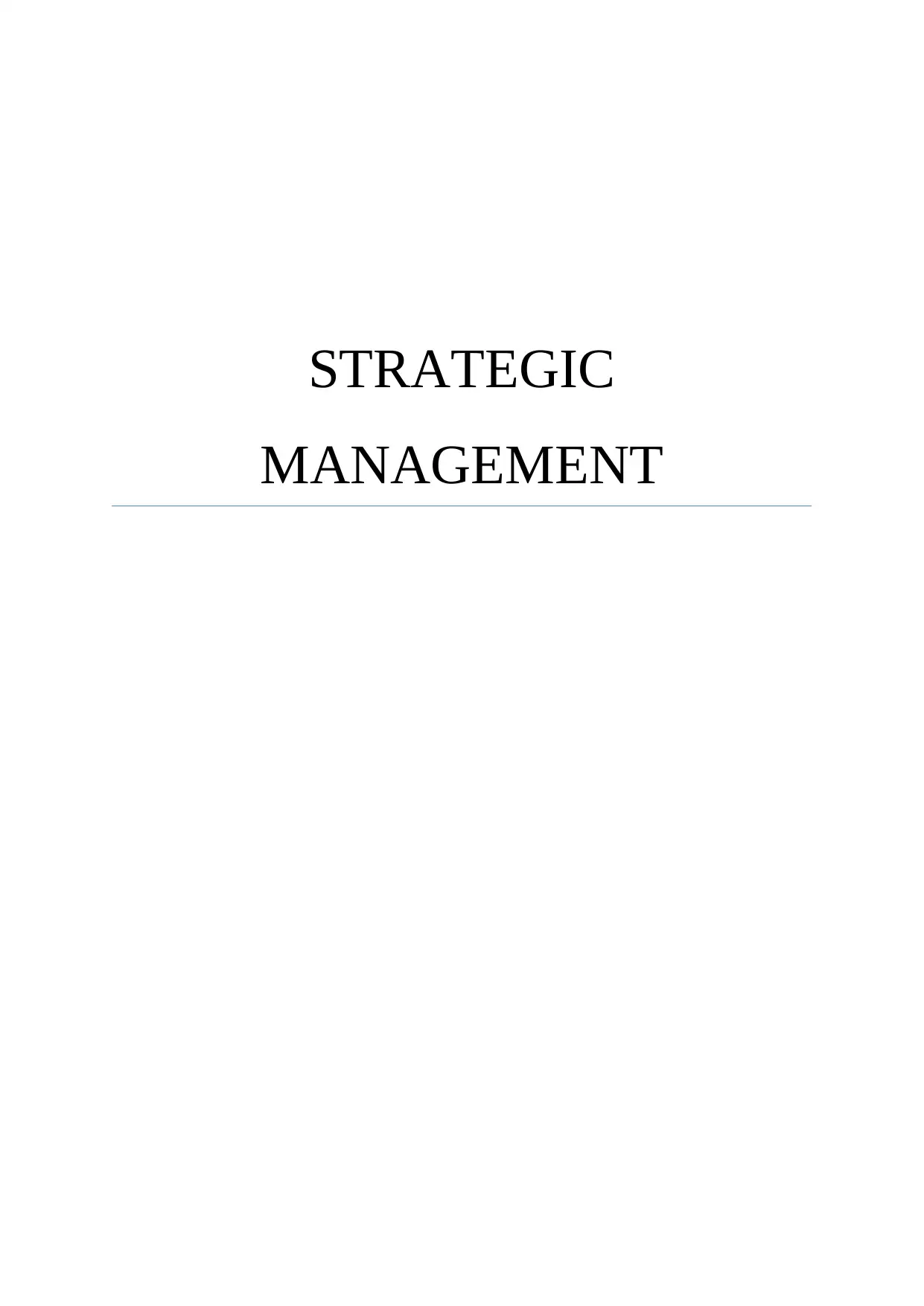
STRATEGIC
MANAGEMENT
MANAGEMENT
Paraphrase This Document
Need a fresh take? Get an instant paraphrase of this document with our AI Paraphraser
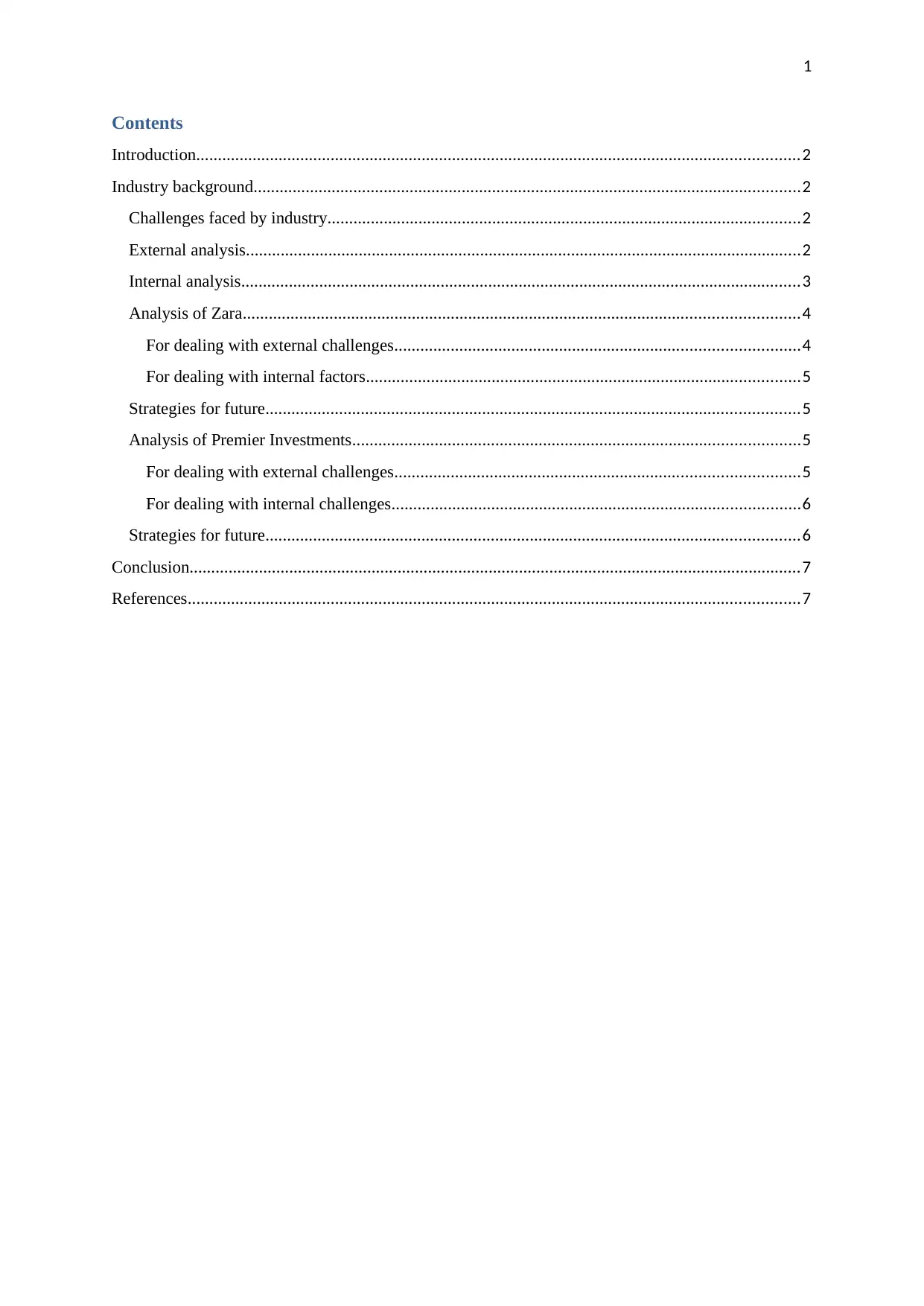
1
Contents
Introduction...........................................................................................................................................2
Industry background..............................................................................................................................2
Challenges faced by industry.............................................................................................................2
External analysis................................................................................................................................2
Internal analysis.................................................................................................................................3
Analysis of Zara................................................................................................................................4
For dealing with external challenges.............................................................................................4
For dealing with internal factors....................................................................................................5
Strategies for future...........................................................................................................................5
Analysis of Premier Investments.......................................................................................................5
For dealing with external challenges.............................................................................................5
For dealing with internal challenges..............................................................................................6
Strategies for future...........................................................................................................................6
Conclusion.............................................................................................................................................7
References.............................................................................................................................................7
Contents
Introduction...........................................................................................................................................2
Industry background..............................................................................................................................2
Challenges faced by industry.............................................................................................................2
External analysis................................................................................................................................2
Internal analysis.................................................................................................................................3
Analysis of Zara................................................................................................................................4
For dealing with external challenges.............................................................................................4
For dealing with internal factors....................................................................................................5
Strategies for future...........................................................................................................................5
Analysis of Premier Investments.......................................................................................................5
For dealing with external challenges.............................................................................................5
For dealing with internal challenges..............................................................................................6
Strategies for future...........................................................................................................................6
Conclusion.............................................................................................................................................7
References.............................................................................................................................................7
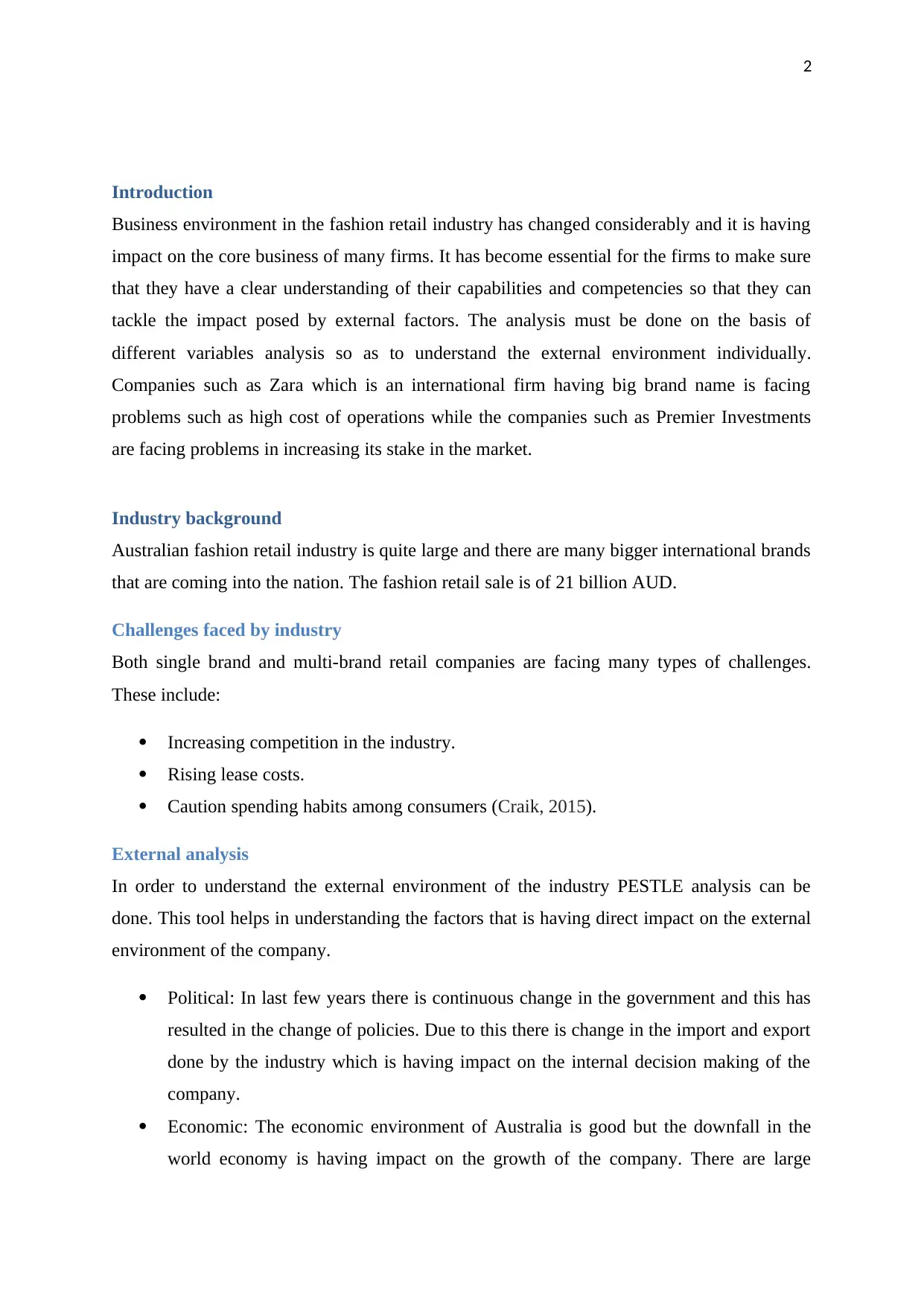
2
Introduction
Business environment in the fashion retail industry has changed considerably and it is having
impact on the core business of many firms. It has become essential for the firms to make sure
that they have a clear understanding of their capabilities and competencies so that they can
tackle the impact posed by external factors. The analysis must be done on the basis of
different variables analysis so as to understand the external environment individually.
Companies such as Zara which is an international firm having big brand name is facing
problems such as high cost of operations while the companies such as Premier Investments
are facing problems in increasing its stake in the market.
Industry background
Australian fashion retail industry is quite large and there are many bigger international brands
that are coming into the nation. The fashion retail sale is of 21 billion AUD.
Challenges faced by industry
Both single brand and multi-brand retail companies are facing many types of challenges.
These include:
Increasing competition in the industry.
Rising lease costs.
Caution spending habits among consumers (Craik, 2015).
External analysis
In order to understand the external environment of the industry PESTLE analysis can be
done. This tool helps in understanding the factors that is having direct impact on the external
environment of the company.
Political: In last few years there is continuous change in the government and this has
resulted in the change of policies. Due to this there is change in the import and export
done by the industry which is having impact on the internal decision making of the
company.
Economic: The economic environment of Australia is good but the downfall in the
world economy is having impact on the growth of the company. There are large
Introduction
Business environment in the fashion retail industry has changed considerably and it is having
impact on the core business of many firms. It has become essential for the firms to make sure
that they have a clear understanding of their capabilities and competencies so that they can
tackle the impact posed by external factors. The analysis must be done on the basis of
different variables analysis so as to understand the external environment individually.
Companies such as Zara which is an international firm having big brand name is facing
problems such as high cost of operations while the companies such as Premier Investments
are facing problems in increasing its stake in the market.
Industry background
Australian fashion retail industry is quite large and there are many bigger international brands
that are coming into the nation. The fashion retail sale is of 21 billion AUD.
Challenges faced by industry
Both single brand and multi-brand retail companies are facing many types of challenges.
These include:
Increasing competition in the industry.
Rising lease costs.
Caution spending habits among consumers (Craik, 2015).
External analysis
In order to understand the external environment of the industry PESTLE analysis can be
done. This tool helps in understanding the factors that is having direct impact on the external
environment of the company.
Political: In last few years there is continuous change in the government and this has
resulted in the change of policies. Due to this there is change in the import and export
done by the industry which is having impact on the internal decision making of the
company.
Economic: The economic environment of Australia is good but the downfall in the
world economy is having impact on the growth of the company. There are large
⊘ This is a preview!⊘
Do you want full access?
Subscribe today to unlock all pages.

Trusted by 1+ million students worldwide
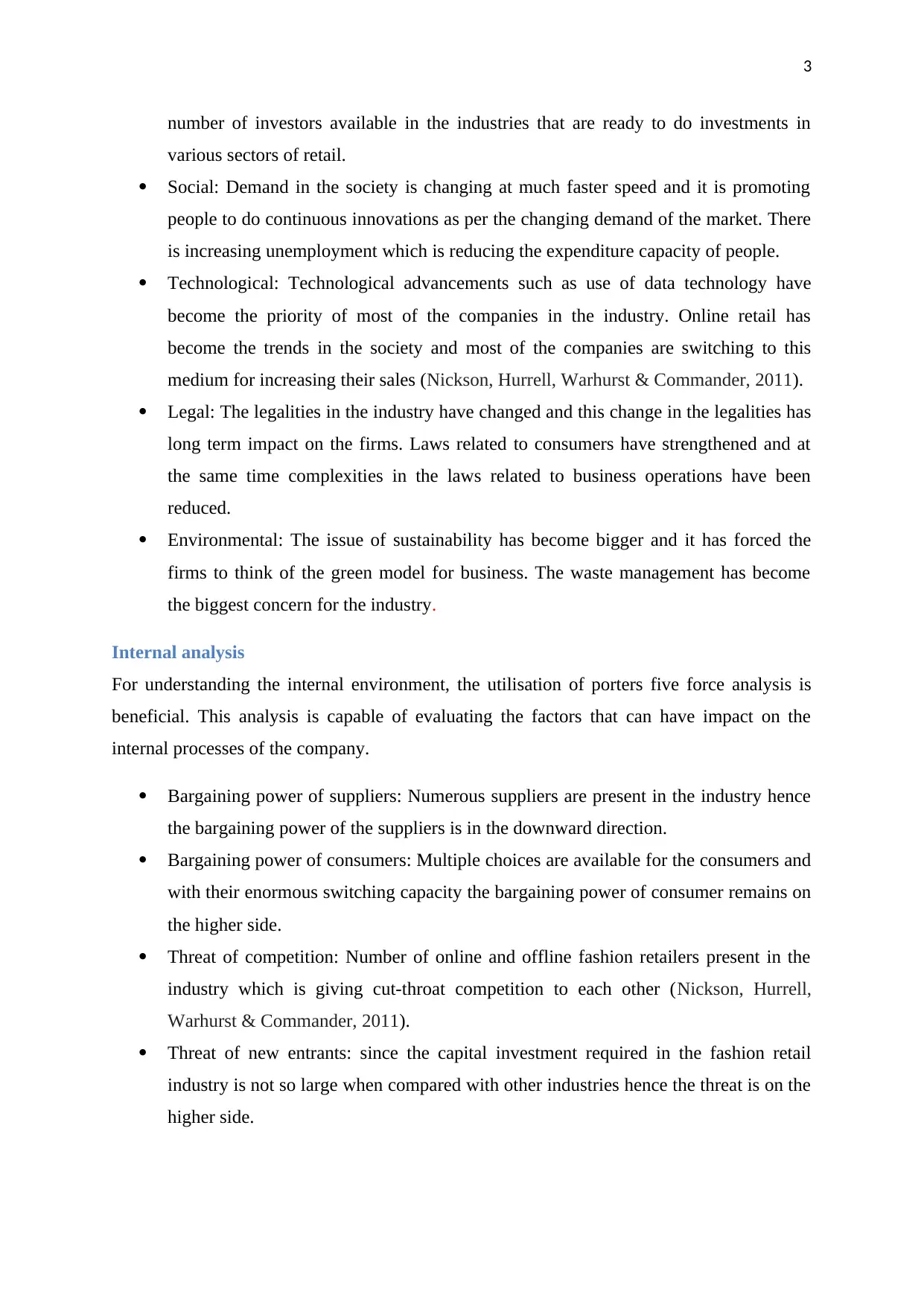
3
number of investors available in the industries that are ready to do investments in
various sectors of retail.
Social: Demand in the society is changing at much faster speed and it is promoting
people to do continuous innovations as per the changing demand of the market. There
is increasing unemployment which is reducing the expenditure capacity of people.
Technological: Technological advancements such as use of data technology have
become the priority of most of the companies in the industry. Online retail has
become the trends in the society and most of the companies are switching to this
medium for increasing their sales (Nickson, Hurrell, Warhurst & Commander, 2011).
Legal: The legalities in the industry have changed and this change in the legalities has
long term impact on the firms. Laws related to consumers have strengthened and at
the same time complexities in the laws related to business operations have been
reduced.
Environmental: The issue of sustainability has become bigger and it has forced the
firms to think of the green model for business. The waste management has become
the biggest concern for the industry.
Internal analysis
For understanding the internal environment, the utilisation of porters five force analysis is
beneficial. This analysis is capable of evaluating the factors that can have impact on the
internal processes of the company.
Bargaining power of suppliers: Numerous suppliers are present in the industry hence
the bargaining power of the suppliers is in the downward direction.
Bargaining power of consumers: Multiple choices are available for the consumers and
with their enormous switching capacity the bargaining power of consumer remains on
the higher side.
Threat of competition: Number of online and offline fashion retailers present in the
industry which is giving cut-throat competition to each other (Nickson, Hurrell,
Warhurst & Commander, 2011).
Threat of new entrants: since the capital investment required in the fashion retail
industry is not so large when compared with other industries hence the threat is on the
higher side.
number of investors available in the industries that are ready to do investments in
various sectors of retail.
Social: Demand in the society is changing at much faster speed and it is promoting
people to do continuous innovations as per the changing demand of the market. There
is increasing unemployment which is reducing the expenditure capacity of people.
Technological: Technological advancements such as use of data technology have
become the priority of most of the companies in the industry. Online retail has
become the trends in the society and most of the companies are switching to this
medium for increasing their sales (Nickson, Hurrell, Warhurst & Commander, 2011).
Legal: The legalities in the industry have changed and this change in the legalities has
long term impact on the firms. Laws related to consumers have strengthened and at
the same time complexities in the laws related to business operations have been
reduced.
Environmental: The issue of sustainability has become bigger and it has forced the
firms to think of the green model for business. The waste management has become
the biggest concern for the industry.
Internal analysis
For understanding the internal environment, the utilisation of porters five force analysis is
beneficial. This analysis is capable of evaluating the factors that can have impact on the
internal processes of the company.
Bargaining power of suppliers: Numerous suppliers are present in the industry hence
the bargaining power of the suppliers is in the downward direction.
Bargaining power of consumers: Multiple choices are available for the consumers and
with their enormous switching capacity the bargaining power of consumer remains on
the higher side.
Threat of competition: Number of online and offline fashion retailers present in the
industry which is giving cut-throat competition to each other (Nickson, Hurrell,
Warhurst & Commander, 2011).
Threat of new entrants: since the capital investment required in the fashion retail
industry is not so large when compared with other industries hence the threat is on the
higher side.
Paraphrase This Document
Need a fresh take? Get an instant paraphrase of this document with our AI Paraphraser
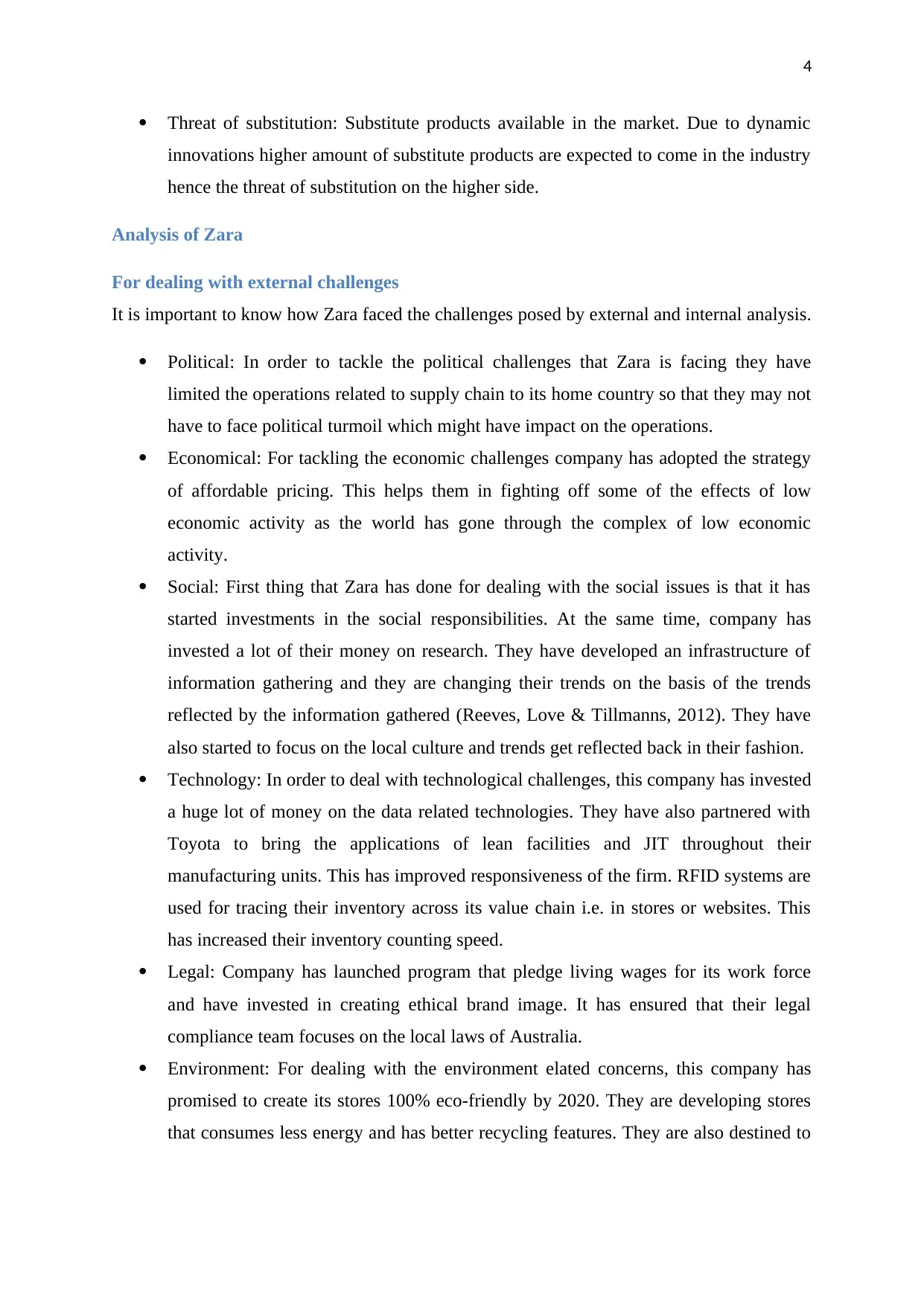
4
Threat of substitution: Substitute products available in the market. Due to dynamic
innovations higher amount of substitute products are expected to come in the industry
hence the threat of substitution on the higher side.
Analysis of Zara
For dealing with external challenges
It is important to know how Zara faced the challenges posed by external and internal analysis.
Political: In order to tackle the political challenges that Zara is facing they have
limited the operations related to supply chain to its home country so that they may not
have to face political turmoil which might have impact on the operations.
Economical: For tackling the economic challenges company has adopted the strategy
of affordable pricing. This helps them in fighting off some of the effects of low
economic activity as the world has gone through the complex of low economic
activity.
Social: First thing that Zara has done for dealing with the social issues is that it has
started investments in the social responsibilities. At the same time, company has
invested a lot of their money on research. They have developed an infrastructure of
information gathering and they are changing their trends on the basis of the trends
reflected by the information gathered (Reeves, Love & Tillmanns, 2012). They have
also started to focus on the local culture and trends get reflected back in their fashion.
Technology: In order to deal with technological challenges, this company has invested
a huge lot of money on the data related technologies. They have also partnered with
Toyota to bring the applications of lean facilities and JIT throughout their
manufacturing units. This has improved responsiveness of the firm. RFID systems are
used for tracing their inventory across its value chain i.e. in stores or websites. This
has increased their inventory counting speed.
Legal: Company has launched program that pledge living wages for its work force
and have invested in creating ethical brand image. It has ensured that their legal
compliance team focuses on the local laws of Australia.
Environment: For dealing with the environment elated concerns, this company has
promised to create its stores 100% eco-friendly by 2020. They are developing stores
that consumes less energy and has better recycling features. They are also destined to
Threat of substitution: Substitute products available in the market. Due to dynamic
innovations higher amount of substitute products are expected to come in the industry
hence the threat of substitution on the higher side.
Analysis of Zara
For dealing with external challenges
It is important to know how Zara faced the challenges posed by external and internal analysis.
Political: In order to tackle the political challenges that Zara is facing they have
limited the operations related to supply chain to its home country so that they may not
have to face political turmoil which might have impact on the operations.
Economical: For tackling the economic challenges company has adopted the strategy
of affordable pricing. This helps them in fighting off some of the effects of low
economic activity as the world has gone through the complex of low economic
activity.
Social: First thing that Zara has done for dealing with the social issues is that it has
started investments in the social responsibilities. At the same time, company has
invested a lot of their money on research. They have developed an infrastructure of
information gathering and they are changing their trends on the basis of the trends
reflected by the information gathered (Reeves, Love & Tillmanns, 2012). They have
also started to focus on the local culture and trends get reflected back in their fashion.
Technology: In order to deal with technological challenges, this company has invested
a huge lot of money on the data related technologies. They have also partnered with
Toyota to bring the applications of lean facilities and JIT throughout their
manufacturing units. This has improved responsiveness of the firm. RFID systems are
used for tracing their inventory across its value chain i.e. in stores or websites. This
has increased their inventory counting speed.
Legal: Company has launched program that pledge living wages for its work force
and have invested in creating ethical brand image. It has ensured that their legal
compliance team focuses on the local laws of Australia.
Environment: For dealing with the environment elated concerns, this company has
promised to create its stores 100% eco-friendly by 2020. They are developing stores
that consumes less energy and has better recycling features. They are also destined to
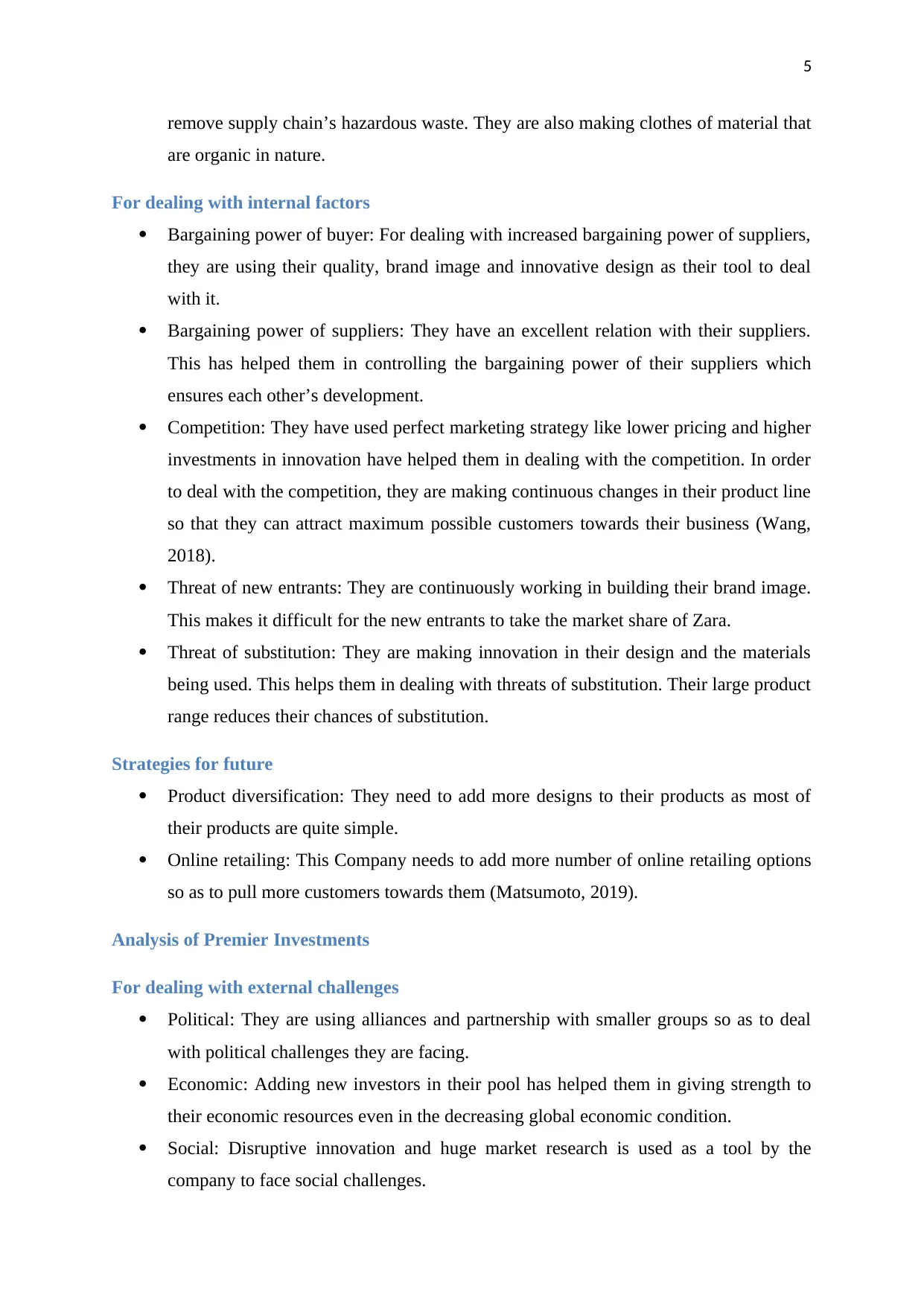
5
remove supply chain’s hazardous waste. They are also making clothes of material that
are organic in nature.
For dealing with internal factors
Bargaining power of buyer: For dealing with increased bargaining power of suppliers,
they are using their quality, brand image and innovative design as their tool to deal
with it.
Bargaining power of suppliers: They have an excellent relation with their suppliers.
This has helped them in controlling the bargaining power of their suppliers which
ensures each other’s development.
Competition: They have used perfect marketing strategy like lower pricing and higher
investments in innovation have helped them in dealing with the competition. In order
to deal with the competition, they are making continuous changes in their product line
so that they can attract maximum possible customers towards their business (Wang,
2018).
Threat of new entrants: They are continuously working in building their brand image.
This makes it difficult for the new entrants to take the market share of Zara.
Threat of substitution: They are making innovation in their design and the materials
being used. This helps them in dealing with threats of substitution. Their large product
range reduces their chances of substitution.
Strategies for future
Product diversification: They need to add more designs to their products as most of
their products are quite simple.
Online retailing: This Company needs to add more number of online retailing options
so as to pull more customers towards them (Matsumoto, 2019).
Analysis of Premier Investments
For dealing with external challenges
Political: They are using alliances and partnership with smaller groups so as to deal
with political challenges they are facing.
Economic: Adding new investors in their pool has helped them in giving strength to
their economic resources even in the decreasing global economic condition.
Social: Disruptive innovation and huge market research is used as a tool by the
company to face social challenges.
remove supply chain’s hazardous waste. They are also making clothes of material that
are organic in nature.
For dealing with internal factors
Bargaining power of buyer: For dealing with increased bargaining power of suppliers,
they are using their quality, brand image and innovative design as their tool to deal
with it.
Bargaining power of suppliers: They have an excellent relation with their suppliers.
This has helped them in controlling the bargaining power of their suppliers which
ensures each other’s development.
Competition: They have used perfect marketing strategy like lower pricing and higher
investments in innovation have helped them in dealing with the competition. In order
to deal with the competition, they are making continuous changes in their product line
so that they can attract maximum possible customers towards their business (Wang,
2018).
Threat of new entrants: They are continuously working in building their brand image.
This makes it difficult for the new entrants to take the market share of Zara.
Threat of substitution: They are making innovation in their design and the materials
being used. This helps them in dealing with threats of substitution. Their large product
range reduces their chances of substitution.
Strategies for future
Product diversification: They need to add more designs to their products as most of
their products are quite simple.
Online retailing: This Company needs to add more number of online retailing options
so as to pull more customers towards them (Matsumoto, 2019).
Analysis of Premier Investments
For dealing with external challenges
Political: They are using alliances and partnership with smaller groups so as to deal
with political challenges they are facing.
Economic: Adding new investors in their pool has helped them in giving strength to
their economic resources even in the decreasing global economic condition.
Social: Disruptive innovation and huge market research is used as a tool by the
company to face social challenges.
⊘ This is a preview!⊘
Do you want full access?
Subscribe today to unlock all pages.

Trusted by 1+ million students worldwide
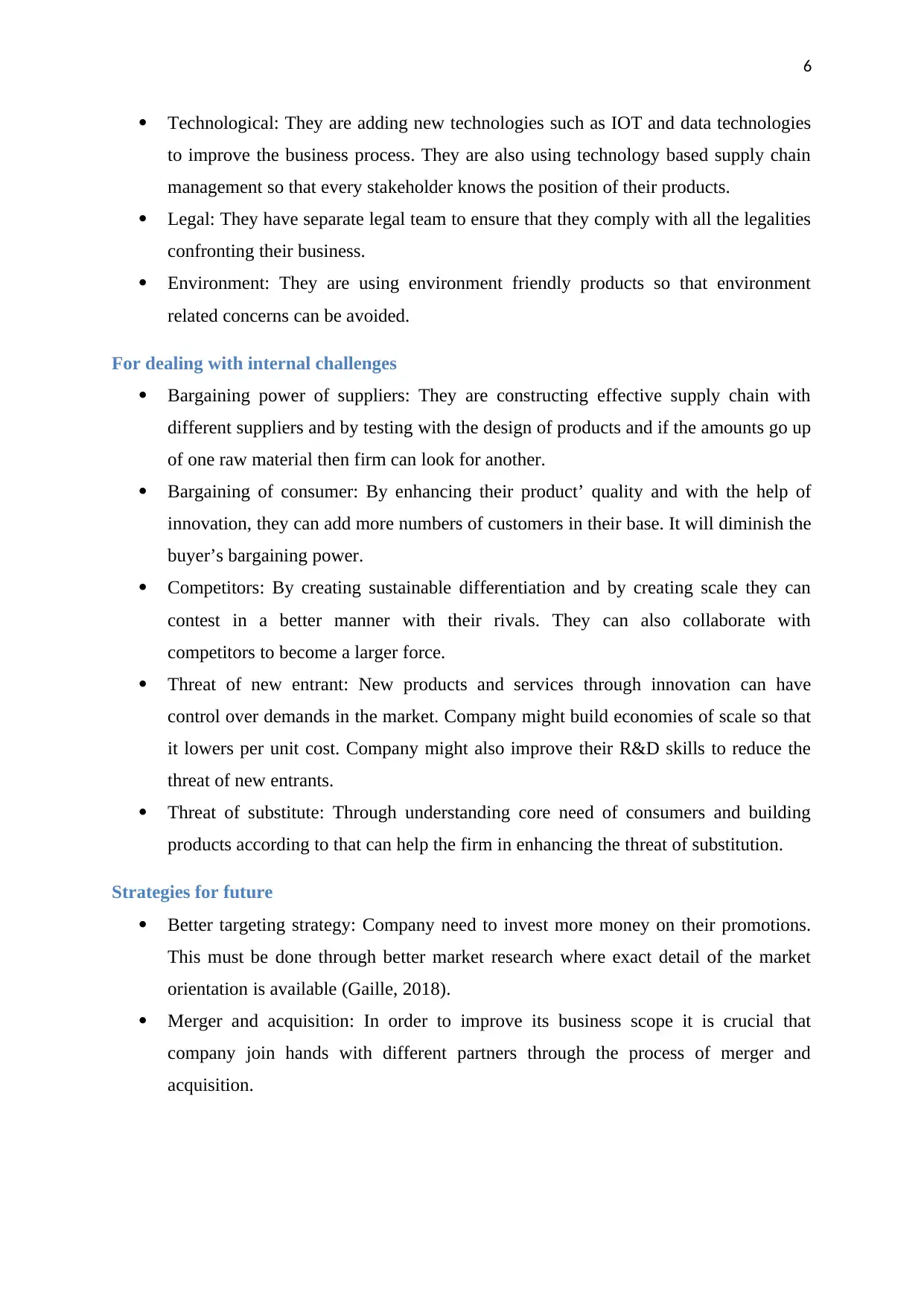
6
Technological: They are adding new technologies such as IOT and data technologies
to improve the business process. They are also using technology based supply chain
management so that every stakeholder knows the position of their products.
Legal: They have separate legal team to ensure that they comply with all the legalities
confronting their business.
Environment: They are using environment friendly products so that environment
related concerns can be avoided.
For dealing with internal challenges
Bargaining power of suppliers: They are constructing effective supply chain with
different suppliers and by testing with the design of products and if the amounts go up
of one raw material then firm can look for another.
Bargaining of consumer: By enhancing their product’ quality and with the help of
innovation, they can add more numbers of customers in their base. It will diminish the
buyer’s bargaining power.
Competitors: By creating sustainable differentiation and by creating scale they can
contest in a better manner with their rivals. They can also collaborate with
competitors to become a larger force.
Threat of new entrant: New products and services through innovation can have
control over demands in the market. Company might build economies of scale so that
it lowers per unit cost. Company might also improve their R&D skills to reduce the
threat of new entrants.
Threat of substitute: Through understanding core need of consumers and building
products according to that can help the firm in enhancing the threat of substitution.
Strategies for future
Better targeting strategy: Company need to invest more money on their promotions.
This must be done through better market research where exact detail of the market
orientation is available (Gaille, 2018).
Merger and acquisition: In order to improve its business scope it is crucial that
company join hands with different partners through the process of merger and
acquisition.
Technological: They are adding new technologies such as IOT and data technologies
to improve the business process. They are also using technology based supply chain
management so that every stakeholder knows the position of their products.
Legal: They have separate legal team to ensure that they comply with all the legalities
confronting their business.
Environment: They are using environment friendly products so that environment
related concerns can be avoided.
For dealing with internal challenges
Bargaining power of suppliers: They are constructing effective supply chain with
different suppliers and by testing with the design of products and if the amounts go up
of one raw material then firm can look for another.
Bargaining of consumer: By enhancing their product’ quality and with the help of
innovation, they can add more numbers of customers in their base. It will diminish the
buyer’s bargaining power.
Competitors: By creating sustainable differentiation and by creating scale they can
contest in a better manner with their rivals. They can also collaborate with
competitors to become a larger force.
Threat of new entrant: New products and services through innovation can have
control over demands in the market. Company might build economies of scale so that
it lowers per unit cost. Company might also improve their R&D skills to reduce the
threat of new entrants.
Threat of substitute: Through understanding core need of consumers and building
products according to that can help the firm in enhancing the threat of substitution.
Strategies for future
Better targeting strategy: Company need to invest more money on their promotions.
This must be done through better market research where exact detail of the market
orientation is available (Gaille, 2018).
Merger and acquisition: In order to improve its business scope it is crucial that
company join hands with different partners through the process of merger and
acquisition.
Paraphrase This Document
Need a fresh take? Get an instant paraphrase of this document with our AI Paraphraser
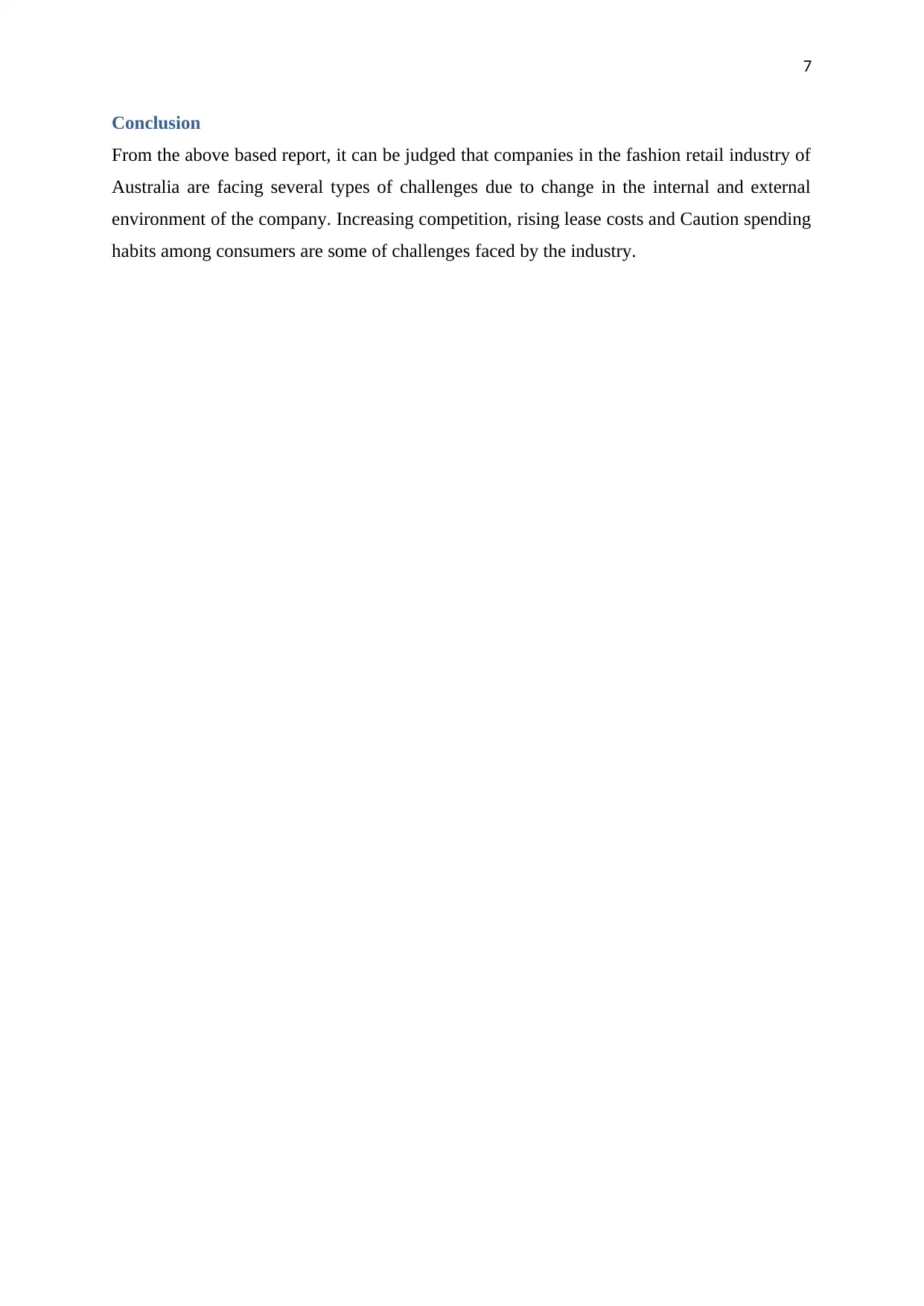
7
Conclusion
From the above based report, it can be judged that companies in the fashion retail industry of
Australia are facing several types of challenges due to change in the internal and external
environment of the company. Increasing competition, rising lease costs and Caution spending
habits among consumers are some of challenges faced by the industry.
Conclusion
From the above based report, it can be judged that companies in the fashion retail industry of
Australia are facing several types of challenges due to change in the internal and external
environment of the company. Increasing competition, rising lease costs and Caution spending
habits among consumers are some of challenges faced by the industry.
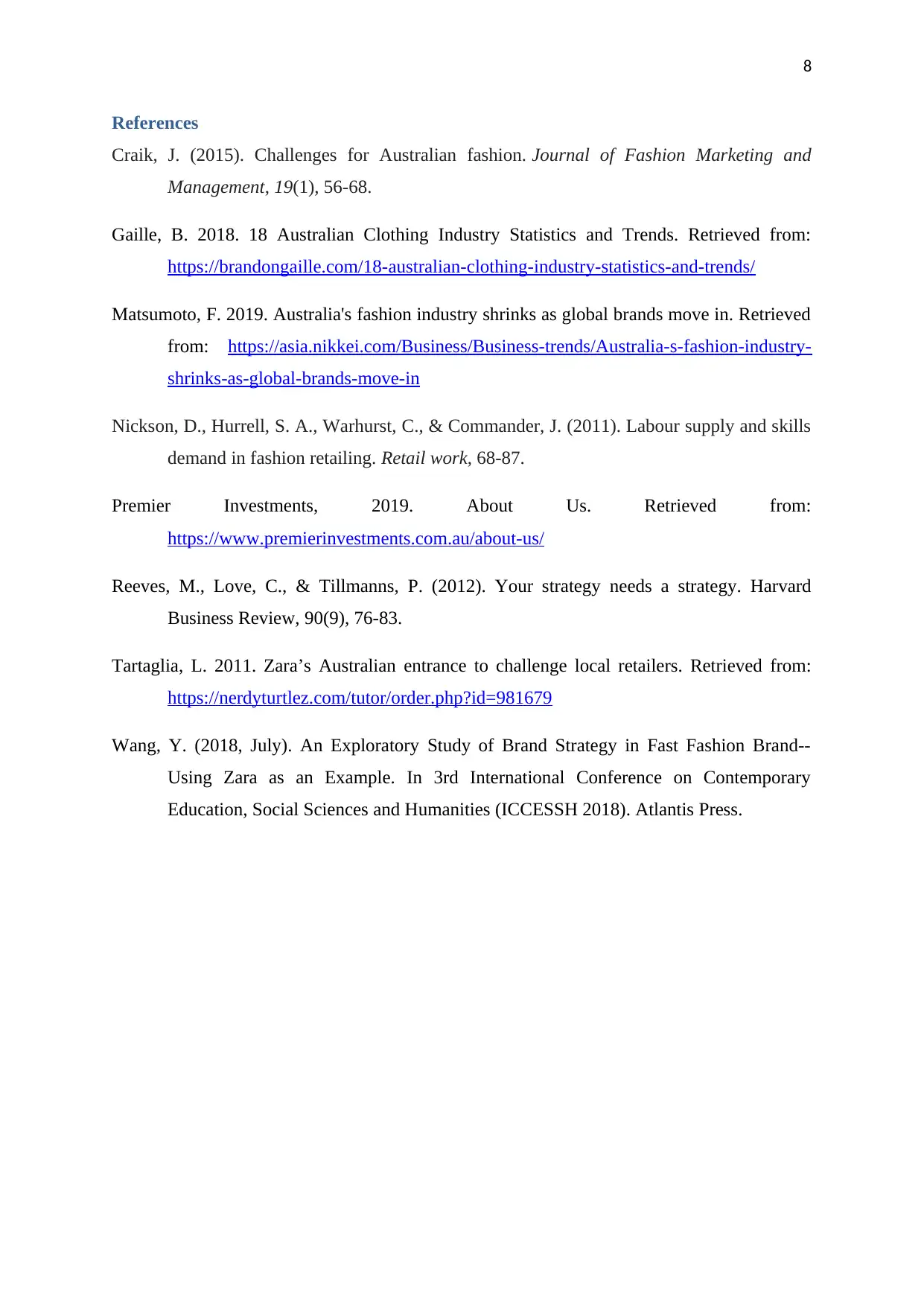
8
References
Craik, J. (2015). Challenges for Australian fashion. Journal of Fashion Marketing and
Management, 19(1), 56-68.
Gaille, B. 2018. 18 Australian Clothing Industry Statistics and Trends. Retrieved from:
https://brandongaille.com/18-australian-clothing-industry-statistics-and-trends/
Matsumoto, F. 2019. Australia's fashion industry shrinks as global brands move in. Retrieved
from: https://asia.nikkei.com/Business/Business-trends/Australia-s-fashion-industry-
shrinks-as-global-brands-move-in
Nickson, D., Hurrell, S. A., Warhurst, C., & Commander, J. (2011). Labour supply and skills
demand in fashion retailing. Retail work, 68-87.
Premier Investments, 2019. About Us. Retrieved from:
https://www.premierinvestments.com.au/about-us/
Reeves, M., Love, C., & Tillmanns, P. (2012). Your strategy needs a strategy. Harvard
Business Review, 90(9), 76-83.
Tartaglia, L. 2011. Zara’s Australian entrance to challenge local retailers. Retrieved from:
https://nerdyturtlez.com/tutor/order.php?id=981679
Wang, Y. (2018, July). An Exploratory Study of Brand Strategy in Fast Fashion Brand--
Using Zara as an Example. In 3rd International Conference on Contemporary
Education, Social Sciences and Humanities (ICCESSH 2018). Atlantis Press.
References
Craik, J. (2015). Challenges for Australian fashion. Journal of Fashion Marketing and
Management, 19(1), 56-68.
Gaille, B. 2018. 18 Australian Clothing Industry Statistics and Trends. Retrieved from:
https://brandongaille.com/18-australian-clothing-industry-statistics-and-trends/
Matsumoto, F. 2019. Australia's fashion industry shrinks as global brands move in. Retrieved
from: https://asia.nikkei.com/Business/Business-trends/Australia-s-fashion-industry-
shrinks-as-global-brands-move-in
Nickson, D., Hurrell, S. A., Warhurst, C., & Commander, J. (2011). Labour supply and skills
demand in fashion retailing. Retail work, 68-87.
Premier Investments, 2019. About Us. Retrieved from:
https://www.premierinvestments.com.au/about-us/
Reeves, M., Love, C., & Tillmanns, P. (2012). Your strategy needs a strategy. Harvard
Business Review, 90(9), 76-83.
Tartaglia, L. 2011. Zara’s Australian entrance to challenge local retailers. Retrieved from:
https://nerdyturtlez.com/tutor/order.php?id=981679
Wang, Y. (2018, July). An Exploratory Study of Brand Strategy in Fast Fashion Brand--
Using Zara as an Example. In 3rd International Conference on Contemporary
Education, Social Sciences and Humanities (ICCESSH 2018). Atlantis Press.
⊘ This is a preview!⊘
Do you want full access?
Subscribe today to unlock all pages.

Trusted by 1+ million students worldwide
1 out of 9
Related Documents
Your All-in-One AI-Powered Toolkit for Academic Success.
+13062052269
info@desklib.com
Available 24*7 on WhatsApp / Email
![[object Object]](/_next/static/media/star-bottom.7253800d.svg)
Unlock your academic potential
Copyright © 2020–2025 A2Z Services. All Rights Reserved. Developed and managed by ZUCOL.





